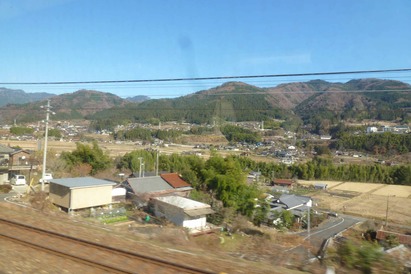We alighted in Nagoya, and, initially, headed for the wrong platform in search of the connection that would take us up into the mountains. Once we’d been redirected we arrived on the right platform to find ourselves beside the Toyama train that takes you through Takayama. It certainly brought back memories.
The train that pulled in a couple of minutes later, so the Public Address system informed us, wasn’t ours. A troop of cleaners scattered along its length swarmed aboard, set about their duties and were in the process of changing the seats around to face the other way when the train pulled out to make room for the Shinano Limited Express.
You’d reckon over three visits to the country I’d have sorted out issues relating to head room, but as I pushed The Red Suitcase into a space designated for such objects I managed to bang the top of my head against an inconveniently placed divider.
We hadn’t been underway long when we made a brief stop at Chikusa in the northeastern suburbs of Nagoya, home to a number of university campuses, and once we were under way again, on the sunny side of the train there was an excuse to remove my jacket. I couldn’t, however, hang it up the way you can on one of the shinkansen services, where there are handy hangers provided.

On the other hand, with the large picture windows giving generous views as we headed into the evergreen mountainside forests, I wasn’t in a position to complain. Mostly, however, we passed through tunnels with spectacular little bits in between that promised spectacular things to come.
Once we were through the tunnels it was a case of back into the urban sprawl at Tajimi, a city in Gifu Prefecture best known for ceramics and pottery, a temple (Eihō-ji) belonging to the Nanzenji faction of the Rinzai school of Zen and a Catholic monastery famous for its wine. The train stopped there, and we were back in the tunnels again as we continued the northward journey. Once we were out of them I reclined the seat to take in the view as the river valley we were following started to narrow and the built landscape gave way to a natural one.
We got our first glimpse of snowy mountains came around 11:42.
There was another stop at Nakatsugawa, a former post town on one of two travel routes that connected Edo (modern-day Tokyo) to the old imperial capital of Kyoto. That’s a minor claim to fame alongside the city’s latter day status as the home of some of the best chestnut delicacies, including kurikinton (boiled and mashed chestnuts, mixed with sugar and reshaped into their original shape) and soft-serve chestnut ice cream.
As we wound our way up into the mountains, I started to get a tad drowsy, but not drowsy enough to miss the bands of bare deciduous trees running down the sides of the slopes interspersed among bands of evergreens.